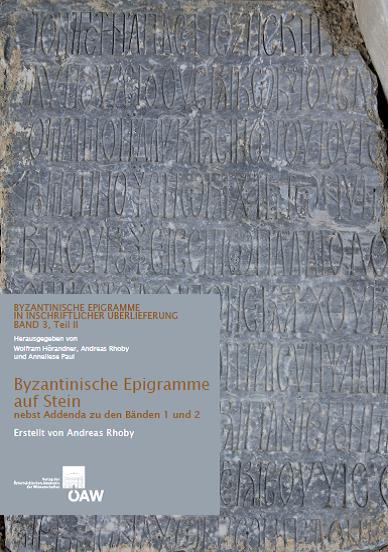


In Byzanz wurde das Genre Epigramm besonders geschätzt. Viele der byzantinischen Epigramme sind bis heute in situ als Inschriften erhalten. Ihre Aufarbeitung zum Ziel setzt sich das auf vier Bände angelegte Projekt „Byzantinische Epigramme in inschriftlicher Überlieferung“. Aus dem im Rahmen des Projekts definierten Untersuchungszeitraum (600 n. Chr. – 1500 n. Chr.) sind mehr als 300 aus Stein gearbeitete Epigramme überliefert, die im vorliegenden dritten Band behandelt werden.
In der ausführlichen Einleitung sowie im gesamten Band wird auf die Bedeutung von metrischen Steininschriften für die byzantinische Kulturgeschichte hingewiesen. Auf Basis der Überlieferung können Steinepigramme in zwei große Gruppen unterteilt werden, nämlich Stifter- und Grabepigramme. Hier wie dort dienten Verse nicht nur der Information über den Akt der Stiftung oder den Tod, sondern waren auch ein Mittel der Selbstrepräsentation der Stifter und der Verstorbenen, d. h. vor allem des Kaisers und der Aristokratie.
Der Hauptteil der Arbeit ist der kritischen Edition der mehr als 300 Epigramme, deren deutscher Übersetzung und dem philologisch-sprachlichen sowie historisch-realienkundlichen Kommentar gewidmet; auch auf paläographische Fragen hinsichtlich der zeitlichen Einordnung der Epigramme wird eingegangen. Zur Veranschaulichung sind fast alle behandelten Epigramme auch bildlich in einem Tafelteil (in Farbe und Schwarzweiß) dokumentiert. Auch im vorliegenden dritten Band der Reihe wird auf die Omnipräsenz inschriftlicher Epigramme in Byzanz hingewiesen und die lang unterschätzte Bedeutung von Inschriften für die byzantinische Kultur unterstrichen.
Gedruckt mit Unterstützung des Fonds zur Förderung der wissenschaftlichen Forschung (FWF).

…
In Byzantium the epigram as a genre was highly appreciated. A considerable number of epigrams is still preserved in situ as inscriptions. Their analysis is the aim of the four planned volumes of the project “Byzantinische Epigramme in inschriftlicher Überlieferung” [“Byzantine epigrams on objects”]. More than 300 and such epigrams preserved on stone, which are treated in the present third volume, are known from the project period 600 AD to 1500 AD. In a detailed introduction as well as in the whole volume the significance of metrical stone inscriptions for Byzantine cultural history is highlighted. On the basis of the preserved material, stone epigrams can be divided into two big groups, namely dedicatory and tomb epigrams. In both cases verses do not only inform us about the foundation act or the death but they are also means for the self-representation of the donor and the deceased, i. e. the emperor and (mainly) the aristocracy. The main part of the book consists of critical editions of the more than 300 epigrams, their German translation, as well as a commentary focusing on philological, linguistical and historical matters; also palaeographic questions are treated concerning the date of the stone epigrams. Images (colour as well as black and white) of almost all epigrams are presented in the tables. Also in this third volume of the series the omnipresence of inscriptional epigrams in Byzantium is stressed and the long underestimated meaning of inscriptions for Byzantine society is highlighted.
2014,
978-3-7001-7601-5
978-3-7001-7752-4
2 Bände mit insgesamt 1047 Seiten, davon 132 Seiten Bildteil,
29,7×21cm, broschiert